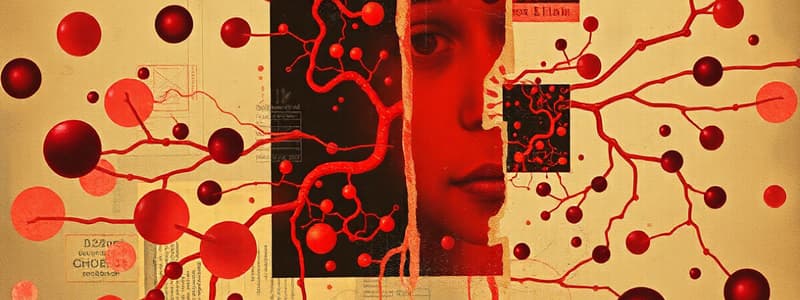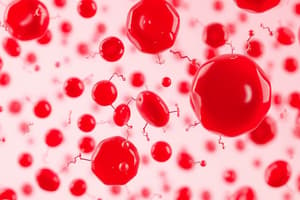Podcast
Questions and Answers
Which of the following best describes the primary function of blood within the circulatory system?
Which of the following best describes the primary function of blood within the circulatory system?
- Generating electrical impulses for nerve function.
- Synthesizing hormones to regulate bodily functions.
- Filtering out toxins and waste products.
- Transporting bodily fluids and facilitating communication between various systems. (correct)
A patient's blood sample is spun down in a centrifuge. If the plasma constitutes 60% of the total blood volume, approximately what percentage would you expect the red blood cells to occupy?
A patient's blood sample is spun down in a centrifuge. If the plasma constitutes 60% of the total blood volume, approximately what percentage would you expect the red blood cells to occupy?
- More than 65%
- Approximately 40% (correct)
- Less than 35%
- About 55%
A researcher is studying the composition of blood plasma. If they are primarily interested in the protein that maintains oncotic pressure, which protein should they focus on?
A researcher is studying the composition of blood plasma. If they are primarily interested in the protein that maintains oncotic pressure, which protein should they focus on?
- Fibrinogen
- Globulin
- Albumin (correct)
- Immunoglobulin
Which of the following plasma components plays a critical role in the formation of blood clots?
Which of the following plasma components plays a critical role in the formation of blood clots?
A patient is experiencing a severe allergic reaction. Which type of plasma protein would likely be elevated in their blood?
A patient is experiencing a severe allergic reaction. Which type of plasma protein would likely be elevated in their blood?
Which of the following statements accurately describes the role of erythrocytes in the transport of respiratory gases?
Which of the following statements accurately describes the role of erythrocytes in the transport of respiratory gases?
Erythrocytes are adapted to efficiently transport oxygen. Which of the following cellular features directly contributes to this function?
Erythrocytes are adapted to efficiently transport oxygen. Which of the following cellular features directly contributes to this function?
A hematologist is examining a blood smear and notes a cell that lacks a nucleus. The cell's dimensions are approximately 7.5 μm in diameter. What is the most likely identity of this cell?
A hematologist is examining a blood smear and notes a cell that lacks a nucleus. The cell's dimensions are approximately 7.5 μm in diameter. What is the most likely identity of this cell?
A researcher is investigating the mechanism by which leukocytes are attracted to sites of inflammation. Which process is most directly involved in this attraction?
A researcher is investigating the mechanism by which leukocytes are attracted to sites of inflammation. Which process is most directly involved in this attraction?
During an infection, leukocytes migrate from the bloodstream into the surrounding tissue. What is the name of the process in which leukocytes squeeze between endothelial cells to exit the bloodstream?
During an infection, leukocytes migrate from the bloodstream into the surrounding tissue. What is the name of the process in which leukocytes squeeze between endothelial cells to exit the bloodstream?
A patient's blood test reveals an elevated number of eosinophils. Which of the following conditions is most likely contributing to this result?
A patient's blood test reveals an elevated number of eosinophils. Which of the following conditions is most likely contributing to this result?
Which type of granulocyte is characterized by a multi-lobed nucleus and the primary function of destroying bacteria?
Which type of granulocyte is characterized by a multi-lobed nucleus and the primary function of destroying bacteria?
A patient presents with symptoms of an allergic reaction. Which type of granulocyte is most likely involved in mediating this response?
A patient presents with symptoms of an allergic reaction. Which type of granulocyte is most likely involved in mediating this response?
A researcher is studying the different types of lymphocytes. Which type of lymphocyte is responsible for antibody production?
A researcher is studying the different types of lymphocytes. Which type of lymphocyte is responsible for antibody production?
Which of the following accurately describes the function of Natural Killer (NK) cells?
Which of the following accurately describes the function of Natural Killer (NK) cells?
A researcher is analyzing a blood sample and identifies large cells (12-20 μm) with kidney-shaped nuclei and basophilic cytoplasm. What type of cell is the researcher most likely observing?
A researcher is analyzing a blood sample and identifies large cells (12-20 μm) with kidney-shaped nuclei and basophilic cytoplasm. What type of cell is the researcher most likely observing?
Which of the following cells are precursors to macrophages, osteoclasts, and microglia?
Which of the following cells are precursors to macrophages, osteoclasts, and microglia?
Platelets play a crucial role in hemostasis. Which of the following describes their primary function?
Platelets play a crucial role in hemostasis. Which of the following describes their primary function?
A hematologist observes numerous cell fragments lacking a nucleus in a blood smear. These fragments are approximately 2-4 μm in diameter. Which type of cell is being observed?
A hematologist observes numerous cell fragments lacking a nucleus in a blood smear. These fragments are approximately 2-4 μm in diameter. Which type of cell is being observed?
A complete blood count (CBC) is ordered for a patient. Which of the following values falls within the normal adult range for hemoglobin (HGB) in females?
A complete blood count (CBC) is ordered for a patient. Which of the following values falls within the normal adult range for hemoglobin (HGB) in females?
A laboratory technician is performing a complete blood count (CBC). Which of the following values would be considered a normal platelet (PLT) count for an adult?
A laboratory technician is performing a complete blood count (CBC). Which of the following values would be considered a normal platelet (PLT) count for an adult?
Which of the following best describes the location and consistency of bone marrow?
Which of the following best describes the location and consistency of bone marrow?
In adults, red bone marrow is primarily found in specific locations. Which of the following includes bones where red marrow is typically active?
In adults, red bone marrow is primarily found in specific locations. Which of the following includes bones where red marrow is typically active?
Which type of bone marrow is primarily composed of fat cells and is considered hematopoietically inactive?
Which type of bone marrow is primarily composed of fat cells and is considered hematopoietically inactive?
A patient is diagnosed with anemia, and their bone marrow is assessed. What transformation might be observed in the patient's yellow bone marrow?
A patient is diagnosed with anemia, and their bone marrow is assessed. What transformation might be observed in the patient's yellow bone marrow?
What type of connective tissue forms the basic structural unit of bone marrow, supporting the cells present within it?
What type of connective tissue forms the basic structural unit of bone marrow, supporting the cells present within it?
Which term describes the process of proliferation and differentiation of erythrocytes from stem cells in the bone marrow?
Which term describes the process of proliferation and differentiation of erythrocytes from stem cells in the bone marrow?
Erythropoiesis is regulated by the concentration of which hormone in the blood?
Erythropoiesis is regulated by the concentration of which hormone in the blood?
Which of the hematopoietic factors is essential for proper erythropoiesis?
Which of the hematopoietic factors is essential for proper erythropoiesis?
During erythropoiesis, a hematopoietic stem cell differentiates through various stages. Which of the following is an early stage in this process?
During erythropoiesis, a hematopoietic stem cell differentiates through various stages. Which of the following is an early stage in this process?
A hematologist is examining a blood smear and identifies an erythroblast that is characterized by a more basophilic cytoplasm. What stage of erythropoiesis is the cell likely in?
A hematologist is examining a blood smear and identifies an erythroblast that is characterized by a more basophilic cytoplasm. What stage of erythropoiesis is the cell likely in?
Which of the following cells found in bone marrow is responsible for producing platelets?
Which of the following cells found in bone marrow is responsible for producing platelets?
In a healthy adult, where would you expect to find the highest concentration of red bone marrow?
In a healthy adult, where would you expect to find the highest concentration of red bone marrow?
What is the approximate lifespan of an erythrocyte in the human body?
What is the approximate lifespan of an erythrocyte in the human body?
Based on the information of normal blood test values, if a patient has a neutrophil count of 8.0 x $10^9$/L, how would you interpret this result?
Based on the information of normal blood test values, if a patient has a neutrophil count of 8.0 x $10^9$/L, how would you interpret this result?
What is the significance of reticular cells in bone marrow?
What is the significance of reticular cells in bone marrow?
How does age typically affect the composition of bone marrow? Choose the best answer.
How does age typically affect the composition of bone marrow? Choose the best answer.
A patient has a genetic defect that impairs their leukocyte adhesion. What specific process would be directly affected by this condition?
A patient has a genetic defect that impairs their leukocyte adhesion. What specific process would be directly affected by this condition?
How do basophils contribute to the inflammatory process?
How do basophils contribute to the inflammatory process?
Flashcards
Blood
Blood
Bodily fluid that transports via the circulatory system and facilitates communication between various systems.
Albumin
Albumin
The most abundant plasma protein, maintaining oncotic pressure.
Globulins
Globulins
Plasma proteins that transport, clot blood, and carry lipoproteins.
Immunoglobulins
Immunoglobulins
Signup and view all the flashcards
Fibrinogen
Fibrinogen
Signup and view all the flashcards
Erythrocytes
Erythrocytes
Signup and view all the flashcards
Chemotaxis
Chemotaxis
Signup and view all the flashcards
Adhesion (Leukocytes)
Adhesion (Leukocytes)
Signup and view all the flashcards
Diapedesis
Diapedesis
Signup and view all the flashcards
Granulocytes
Granulocytes
Signup and view all the flashcards
Neutrophils
Neutrophils
Signup and view all the flashcards
Eosinophils
Eosinophils
Signup and view all the flashcards
Basophils
Basophils
Signup and view all the flashcards
Lymphocytes
Lymphocytes
Signup and view all the flashcards
T Cytotoxic (Tc) Cells
T Cytotoxic (Tc) Cells
Signup and view all the flashcards
T Helper (Th) Cells
T Helper (Th) Cells
Signup and view all the flashcards
T Regulatory (Treg) Cells
T Regulatory (Treg) Cells
Signup and view all the flashcards
B Lymphocytes
B Lymphocytes
Signup and view all the flashcards
NK Cells
NK Cells
Signup and view all the flashcards
Monocytes
Monocytes
Signup and view all the flashcards
Platelets
Platelets
Signup and view all the flashcards
Bone Marrow
Bone Marrow
Signup and view all the flashcards
Yellow Bone Marrow
Yellow Bone Marrow
Signup and view all the flashcards
Red Bone Marrow
Red Bone Marrow
Signup and view all the flashcards
Erythropoiesis
Erythropoiesis
Signup and view all the flashcards
Study Notes
- Blood is a bodily fluid that transports substances via the circulatory system.
- Blood facilitates communication between body systems and functions as a fluid connective tissue.
Components of Plasma
- Plasma contains albumin, the most abundant plasma protein, involved in maintaining oncotic pressure (58%).
- Globulins (alpha and beta) transport proteins like transferrin, blood clotting factors, and lipoproteins, constituting 37% of plasma.
- Immunoglobulins (gamma-globulins) are antibodies involved in immune reactions.
- Fibrinogen polymerizes during clotting to form fibrin, which aids in stopping bleeding from small vessels, and makes up 4% of plasma.
- Complement system proteins participate in immune reactions.
- Ions found in plasma include Sodium, Potassium, Calcium, Iron, Hydrogen(H+), Chloride, Bicarbonate, and Phosphate
- Other components of plasma include amino acids, glucose, cholesterol, vitamins, fatty acids, oxygen and carbon dioxide
- Oxygen in plasma is 2% dissolved, and 98% bound to hemoglobin.
- Carbon dioxide in plasma is 7% dissolved, 66% as bicarbonate ions, and 27% bound to hemoglobin.
- Creatinine urea, bilirubin, and ammonia are excretory products found in plasma.
Erythrocytes
- Erythrocytes are round, biconcave cells lacking a cell nucleus.
- Erythrocytes measure 7.5 μm in diameter, with a peripheral thickness of 2.6 μm and a central thickness of 0.75 μm.
- Erythrocytes are filled with hemoglobin, transport 98% of oxygen and 27% of carbon dioxide.
- Erythrocytes have a lifespan of approximately 120 days.
- Erythrocytes undergo anaerobic metabolism.
Leukocyte Activation
- Chemotaxis attracts leukocytes to infection or inflammation sites via cytokines and chemokines from damaged tissues.
- Adhesion occurs when leukocytes stick to endothelial cells lining blood vessels near infection or inflammation, mediated by adhesion molecules like integrins.
- Diapedesis is the process by which leukocytes squeeze through endothelial cells to exit the bloodstream and enter surrounding tissue, guided by chemical signals.
Granulocytes
- Granulocytes are a type of white blood cell characterized by having a two-lobed or multi-lobed nucleus.
- Granulocytes contain specialized lysosomes (azurophilic granules) and specific granules with proteins that have functions specific to the cell type.
- Neutrophils are the most abundant granulocytes, characterized by a polymorphic, multi-lobed nucleus and numerous fine cytoplasmic granules, and their primary function is to destroy bacteria within phagolysosomes.
- Eosinophils have a two-lobed nucleus and numerous eosinophilic granules, and mainly respond against parasites and modulate the inflammatory response.
- Basophils are the rarest granulocytes, with an irregularly shaped two-lobed nucleus and strongly basophilic granules, and participate in allergic and inflammatory reactions.
- Neutrophils measure 12-15 μm in size, they comprise 50-70% of leukocytes, circulate in the bloodstream for 6-8 hours, then migrate to tissues for 1-4 days, and undergo apoptosis.
- Basophils measure 12-15 μm, make up less than 1% of leukocytes, reside in bone marrow for 8 days, then circulate in the blood for 3 days, rarely migrating to tissues, and undergo apoptosis.
Studying That Suits You
Use AI to generate personalized quizzes and flashcards to suit your learning preferences.




